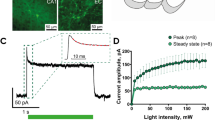Abstract
The ionic requirements for K+-evoked efflux of endogenous taurine from primary cerebellar astrocyte cultures were studied. The Ca2+ ionophore A23187 evoked taurine efflux in a dose-dependent fashion with a time-course identical to that of K+-induced efflux. The Ca2+-channel antagonist nifedipine had no effect upon efflux induced by 10 or 50 mM K+. In addition, verapamil did not antagonize 50 mM K+-evoked efflux except at high, non-pharmacological concentrations (>100 μM), and preincubation with 2 μM ω-conotoxin had no effect on 50 mM K+-evoked efflux. Similarly, preincubation with 1 mM ouabain had no effect on the amount of taurine released by K+ stimulation, but did accelerate the onset of efflux by 2–4 min. Although 2 μM tetrodotoxin had no effect on K+-evoked release, replacing Na+ with choline abolished the taurine efflux seen in response to K+ stimulation. Together, these findings suggest that neuronal N- and L-type Ca2+- and voltage-dependent Na+-channels are not involved in the influx of Ca2+ which appears to be necessary for K+-evoked taurine efflux, and that in addition to Ca2+, extracellular Na+ is also required.
Similar content being viewed by others
References
Lehman, A. 1987. Evidence for a direct action of N-methylaspartate on non-neuronal cells. Brain Res. 411:95–101.
Huxtable, R. J., and Sebring, L. A. 1986. Towards a unifying theory for the actions of taurine. TIPS 7:481–485.
Wright, C. E., Tallan, H. H., and Lin, Y. Y. 1986. Taurine: Biological update. Ann. Rev. Biochem. 55:427–453.
Okamoto, K., and Namina, M. 1978. Uptake, release and homo- and hetero-exchange diffusions of inhibitory amino acids in guinea-pig cerebellar slices. J. Neurochem. 31:1393–1402.
Kerwin, R. W., and Pycock, R. J. 1979. Role of taurine as a possible transmitter in the thermoregulatory pathways of the rat. J. Pharm. Pharmacol. 31:466–470.
Placheta, P., Singer, E., Sieghart, W., and Karobath, M. 1979. Properties of [3H]taurine release from crude synaptosomal fractions of rat cerebral cortex. Neurochem. Res. 4:703–712.
Holopainen, I., Kontro, P., and Oja, S. S. 1985. Release of preloaded taurine and hypotaurine from astrocytes in primary culture: Stimulation by calcium-free media. Neurochem. Res. 10:123–131.
Oja, S. S., Korpi, E. R., Holopainen, I., and Kontro, P. 1985. Mechanisms of stimulated taurine release from nervous tissue. Pages 237–289,in Oja, S. S., Ahtee, L., Kontro, P., and Paasonen, M. K., (eds.), Taurine: Biological Actions and Clinical Perspectives, Alan R. Liss, Inc., New York.
Pin, J., Weiss, S., Sebben, M., Kemp, D. and Bockaert, J. 1986. Release of endogenous amino acids from striatal neurons in primary culture. J. Neurochem. 47:594–603.
Sieghart, W. and Heckl, K. 1976. Potassium-evoked release of taurine from synaptosomal fractions of rat cerebral cortex. Brain Res. 116:538–543.
Oja, S. S. and Kontro, P. 1987. Cation effects on taurine release from brain slices: comparison to GABA. J. Neurosci. Res. 17:302–311.
Hanretta, A. T. and Lombardini, J. B. 1986. Properties of spontaneous and evoked release of taurine from hypothalamic crude P2 synaptosomal preparations. Brain Res. 378:205–215.
Schrier, B. K. and Thompson, E. J. 1974. On the role of glial cells in the mammalian nervous system. J. Biol. Chem. 249:1769–1780.
Philibert, R. A., Rogers, K. L., Allen, A. J. and Dutton, G. R. 1988. Dose-dependent K+-stimulated efflux of endogenous taurine from primary astrocyte cultures is Ca2+-dependent. J. Neurochem. 51:122–126.
MacVicar, B. A. 1984. Voltage-dependent calcium channels in glial cells. Science 226:1345–1347.
Dutton, G. R., Currie, D. N., and Tear, K. 1981. An improved method for the bulk isolation of viable perikarya from postnatal cerebellum. J. Neurosci. Methods 3:421–427.
Pearce, B. R., Currie, D. N., Dutton, G. R., Hussey, R. E. G., Beale, R., and Pigott, R. 1981. A simple perfusion chamber for studying neurotransmitter release from cells maintained in monolayer culture. J. Neurosci. Methods 3:255–259.
Rogers, K. L., Philibert, R. A., Allen, A. J., Molitor, J., Wilson, E. J., and Dutton, G. R. 1987. HPLC analysis of putative amino acid neurotransmitters released from primary cerebellar cultures. J. Neurosci. Methods 22:173–179.
Reed, P. W., and Lardy, H. A. 1974. A23187: A divalent cation ionophore. J. Biol. Chem. 247:6970–6977.
Pfeiffer, D. R., and Lardy, H. A. 1976. Ionophore A23187: the effect of H+ concentration on complex formation with divalent and monovalent cations and the demonstration of K+ transport in mitochondria mediated by A23187. Biochem. 15:935–943.
Flatman, P., and Lew, V. L. 1977. Does ionophore A23187 mediate Na transport in the absence of divalent cations? Nature 270:444–445.
Waltz, W., and Wilson, D. C. 1986. Calcium entry into cultured mouse astrocytes. Neurosci. Lett. 67:301–306.
Miller, R. J. 1987. Multiple calcium channels and neuronal function. Science 235:46–52.
McCleskey, E. W., Fox, A. P., Feldman, D. H., Cruz, L. J., Olivera, B. M., Tsien, R. W., and Yoshikami, D. 1987. ω-conotoxin: Direct and persistent blockade of specific types of calcium channels in neurons but not muscle. Proc. Natl. Acad. Sci. USA 84:4327–4331.
Hirning, L. D., Fox, A. P., McCleskey, E. W., Olivera, B. M., Thayer, S. A., Miller, R. J., and Tsien, R. W. 1988. Dominant role on N-type Ca2+-channels in evoked release of norepinephrine from sympathetic neurons. Science 239:57–61.
Janis, R. A., and Triggle, D. J. 1983. New developments in Ca2+ channel antagonists. J. Med. Chem. 26:775–785.
Miller, R. J., and Freedman, S. B. 1984. Are dihydropyridine binding sites voltage sensitive calcium channels? Life Sci. 34:1205–1221.
Hojvat, S. A., Musch, M. W., and Miller, R. J. 1983. Stimulation of prostaglandin production in rabbit illeal mucosa by bradykinin. J. Pharmacol. Exp. Ther. 226:749–755.
McGee, R., and Schneider, J. E. 1979. Inhibition of high affinity synaptosomal uptake systems by verapamil. Mol. Pharmacol. 16:877–885.
Galper, J. B., and Catterall, W. A. 1979. Inhibition of sodium channels by D600. Mol. Pharmacol. 15:174–178.
Korpi, E. R., and Oja, S. S. 1983. Characteristics of taurine release from cerebral cortical slices induced by sodium-deficient media. Brain Res. 289:197–204.
Author information
Authors and Affiliations
Rights and permissions
About this article
Cite this article
Philibert, R.A., Rogers, K.L. & Dutton, G.R. K+-evoked taurine efflux from cerebellar astrocytes: On the roles of Ca2+ and Na+ . Neurochem Res 14, 43–48 (1989). https://doi.org/10.1007/BF00969756
Accepted:
Issue Date:
DOI: https://doi.org/10.1007/BF00969756




